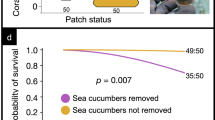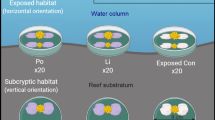Abstract
An outbreak of a small sessile sea cucumber, Ocnus sanya, occurred on the degraded Luhuitou coral reef in Sanya Bay, Hainan, China. This study explored the pattern of distribution of O. sanya on the reef and the impacts of the high abundance of O. sanya on post-settlement mortality of Pocillopora damicornis recruits. The density of O. sanya ranged from about 500 to over 2000 individuals m−2 with 10.95–23.69% cover on hard substrate. Terracotta tiles with O. sanya on the surface accumulated 19.7% more surface sediment than those without sea cucumbers. Post-settlement P. damicornis recruits had significantly higher mortality on terracotta tiles with O. sanya than those without O. sanya after 21 d. Overall, O. sanya appears to increase sediment stress and inhibit coral recruitment, exacerbating the degradation of Luhuitou Reef. This study raises the possibility that such novel outbreak species could contribute significant additional stress on coral reefs at larger scales.





Similar content being viewed by others
References
Arévalo R, Pinedo S, Ballesteros E (2007) Changes in the composition and structure of Mediterranean rocky-shore communities following a gradient of nutrient enrichment: descriptive study and test of proposed methods to assess water quality regarding macroalgae. Mar Pollut Bull 55:104–113
Bailey SA (2015) An overview of thirty years of research on ballast water as a vector for aquatic invasive species to freshwater and marine environments. Aquat Ecosyst Health 18:261–268
Bellwood DR, Hughes TP, Folke C, Nystrom M (2004) Confronting the coral reef crisis. Nature 429:827–833
Birrell CL, McCook LJ, Willis BL, Diaz-Pulido GA (2008) Effects of benthic algae on the replenishment of corals and the implications for the resilience of coral reefs. Oceanogr Mar Biol Annu Rev 46:25–63
Cao D, Cao WZ, Liang Y, Huang Z (2016) Nutrient variations and isotopic evidences of particulate organic matter provenance in fringing reefs, South China. Sci Total Environ 566:378–386
Chui PYA, Ang PO (2010) Massive overgrowth of coral recruits by barnacles in winter low-temperature conditions, Hong Kong, China. Coral Reefs 29:1017
Eckert GL (2007) Spatial patchiness in the sea cucumber Pachythyone rubra in the California Channel Islands. J Exp Mar Bio Ecol 348:121–132
Fabricius KE (2005) Effects of terrestrial runoff on the ecology of corals and coral reefs: review and synthesis. Mar Pollut Bull 50:125–146
Gómez JA, Nearing MA (2005) Runoff and sediment losses from rough and smooth soil surfaces in a laboratory experiment. Catena 59:253–266
Huang H, Li XB, Yang JH, Lian JS, Huang LM (2009) An outbreak of the colonial sand tube worm, Phragmatopoma sp. threatens the survival of scleractinian corals. Zoological Studies 48:106
Hume BCC, D’Angelo C, Cunnington A, Smith EG, Wiedenmann J (2014) The corallivorous flatworm Amakusaplana acroporae: an invasive species threat to coral reefs? Coral Reefs 33:267–272
Kohler EK, Gill SM (2006) Coral Point Count with Excel extensions (CPCe): a Visual Basic program for the determination of coral and substrate coverage using random point count methodology. Comput Geosci 32:1259–1269
Li XB (2011) Identification of major factors influencing the composition, spatial and temporal variation of scleractinian coral community in Sanya, China. Ph.D. thesis, Chinese Academy of Sciences
McCook LJ, Folke C, Hughes T, Nyström M, Obura D, Salm R (2007) Ecological resilience, climate change and the Great Barrier Reef. In: Johnson JE, Marshall PA (eds) Climate change and the Great Barrier Reef, a vulnerability assessment. Great Barrier Reef Marine Park Authority and Australian Greenhouse Office, Australia, pp 75–96
Perez K, Rodgers KS, Jokiel PL, Lager CV, Lager DJ (2014) Effects of terrigenous sediment on settlement and survival of the reef coral Pocillopora damicornis. PeerJ 2:e387
Rodgers SA, Bingham BL (1996) Subtidal zonation of the holothurian Cucumaria lubrica (Clark). J Exp Mar Bio Ecol 204:113–129
Rogers CS (1990) Responses of coral reefs and reef organisms to sedimentation. Mar Ecol Prog Ser 62:185–202
Tkachenko KS, Britayev TA, Huan NH, Pereladov MV, Latypov YY (2016) Influence of anthropogenic pressure and seasonal upwelling on coral reefs in Nha Trang Bay (Central Vietnam). Mar Ecol 37:1131–1146
Yeemin T, Pengsakun S, Yucharoen M, Klinthong W, Sangmanee K, Sutthacheep M (2013) Long-term changes in coral communities under stress from sediment. Deep Sea Res Part 2 Top Stud Oceanogr 96:32–40
You F, Huang H, Zhang Y (2013) The description of a new cucumariid species from Hainan Island and preliminary study of phylogenetic relation. Chin Sci Bull 58:1604–1609
Zhang YY, Huang H, Huang JY (2014) A sea cucumber outbreak on a degraded coral reef in Sanya, China. Coral Reefs 33:1077
Zhao MX, Yu KF, Zhang QM, Qi S (2009) Evolution and its environmental significance of coral diversity on Luhuitou fringing reef, Sanya. Marine Environmental Science 28:125–130
Acknowledgements
This study was funded by the Strategic Priority Research Program of the Chinese Academy of Sciences (XDA13020201), the National Nature Science Foundation of China (41676150 and 31370499), Science and Technology Service Network Initiative (KFJ-EW-STS-123), Science and technology Planning Project of Guangdong Province, China (2014B030301064). L. J. McCook was supported by a President’s International Visiting Expert Professorial Fellowship from the Chinese Academy of Sciences (2016VEA025). We are grateful to reviewers for their valuable and constructive comments that vastly improved the manuscript. On behalf of all authors, the corresponding author states that there is no conflict of interest.
Author information
Authors and Affiliations
Corresponding author
Additional information
Communicated by Biology Editor Dr. Mark R. Patterson
Rights and permissions
About this article
Cite this article
Zhang, YY., McCook, L., Jiang, L. et al. An outbreak of sea cucumbers hinders coral recruitment. Coral Reefs 37, 321–326 (2018). https://doi.org/10.1007/s00338-017-1654-x
Received:
Accepted:
Published:
Issue Date:
DOI: https://doi.org/10.1007/s00338-017-1654-x




